Growing up: how do we assess team skills
Hello! I am Vanya Solovyov , design director of DocDoc (part of the Sberbank group). Today heading Dream-Tim , which tells how to create a dream team.
For the development of our design team, we stopped at two tools. And they complement each other.
We have implemented a transparent growth system that solves long-term problems:
')
Helps to develop point hard and soft skills of each designer.
For a better understanding of how these two tools work, imagine that:

I talked about levels in design in one of the past articles . Today I will talk about the assessment of skills: why this tool is needed, how we implement it and what we do with the data obtained.
Designer's work is a set of versatile skills. Some are well developed, others are bad. This is normal when we “pump over” skills depending on the scope of their application.
But self-examination is difficult. Therefore, we have collected professional skills and grouped them into sections:
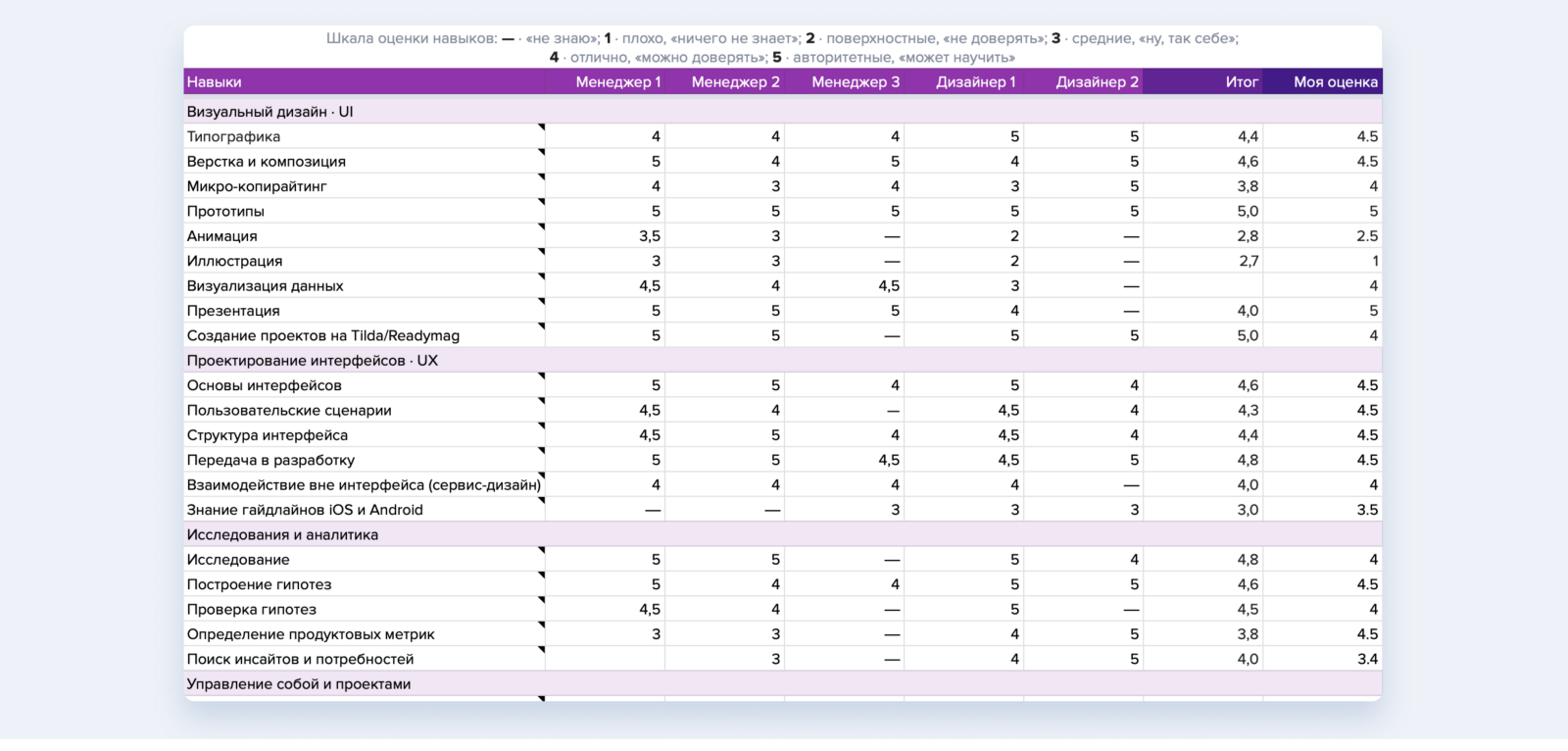
Table link
Thanks to Yura Vetrov for the basic concept of the idea, which we adopted and developed to fit our needs.
We conduct an assessment every six months and, in order to be fairly objective, we stopped at this set of participants for each designer:
So that everyone understands the terminology of skills in the same way, when you hover over them, a hint appears with a description.
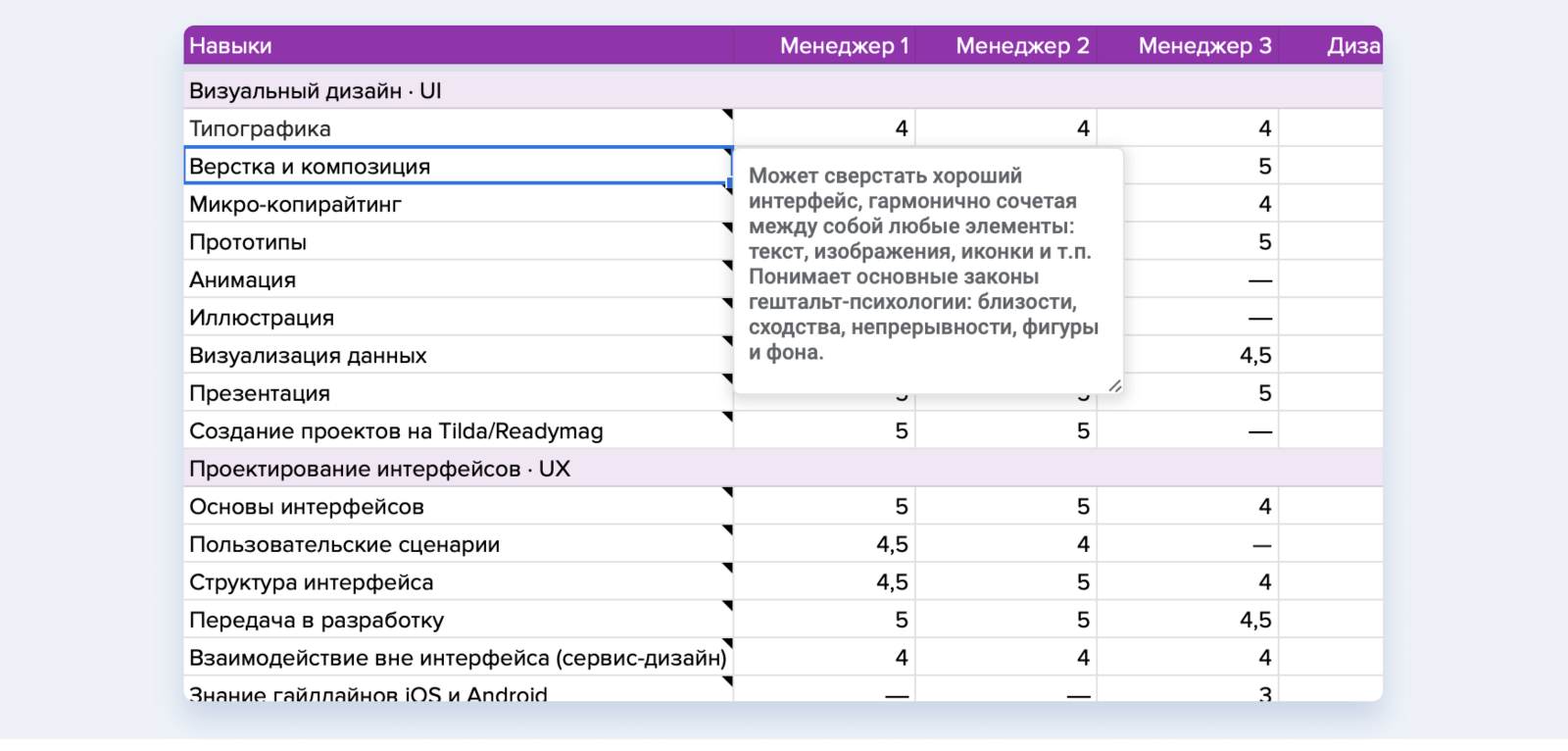
Each skill has a short description.
Evaluation of skills occurs on a five-point system:
After several assessments, it was noticed that the guys often put fractional values - it means the scale is not enough. In version 3.0, let's move to a ten-point system.
To obtain objective results, we divided the final grade into two:
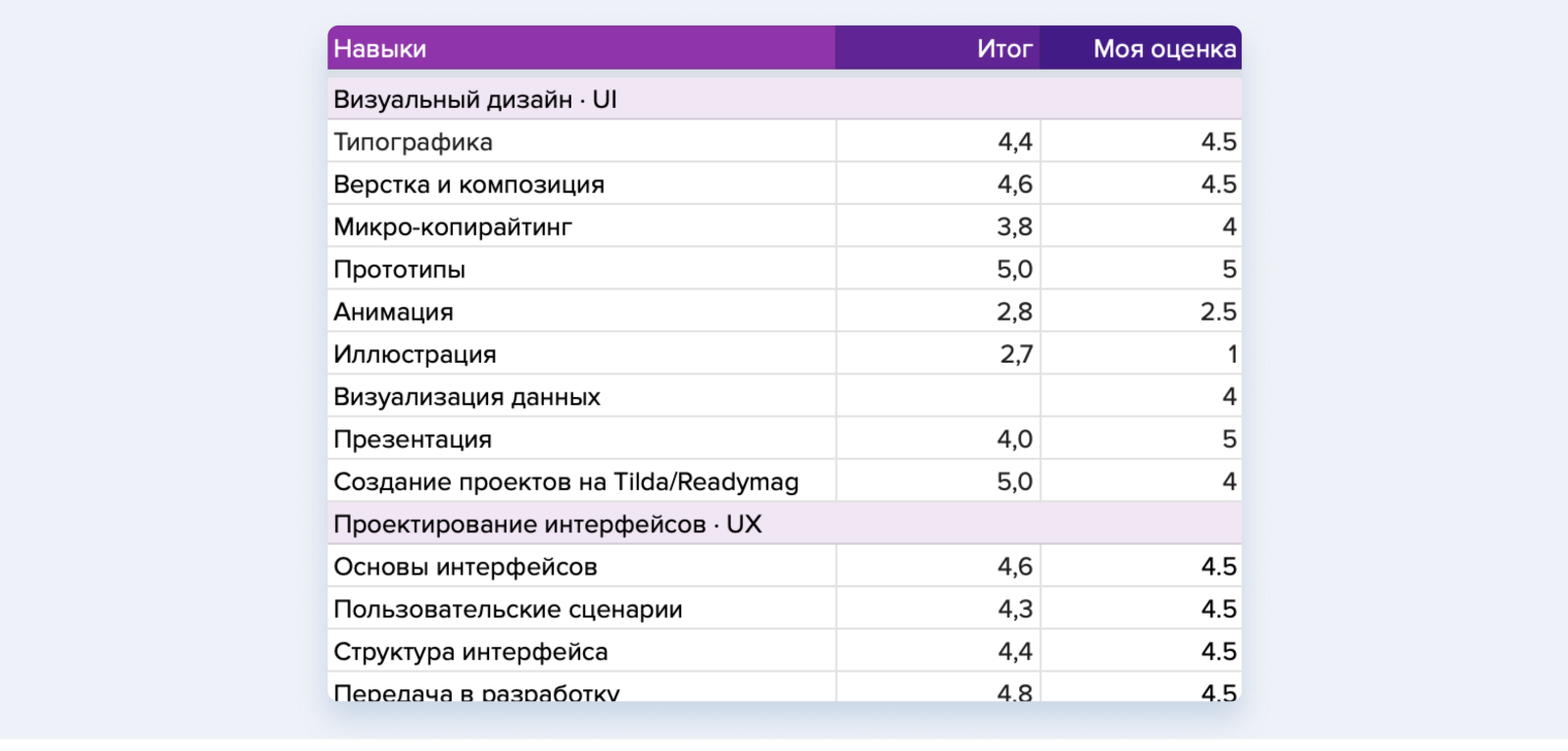
This helps the designer himself to see two pictures of the world - how they see him from a colleague and how he positions himself. This works if more than two people have rated.
In a separate tab, each designer can see the results of colleagues and compare themselves with them.
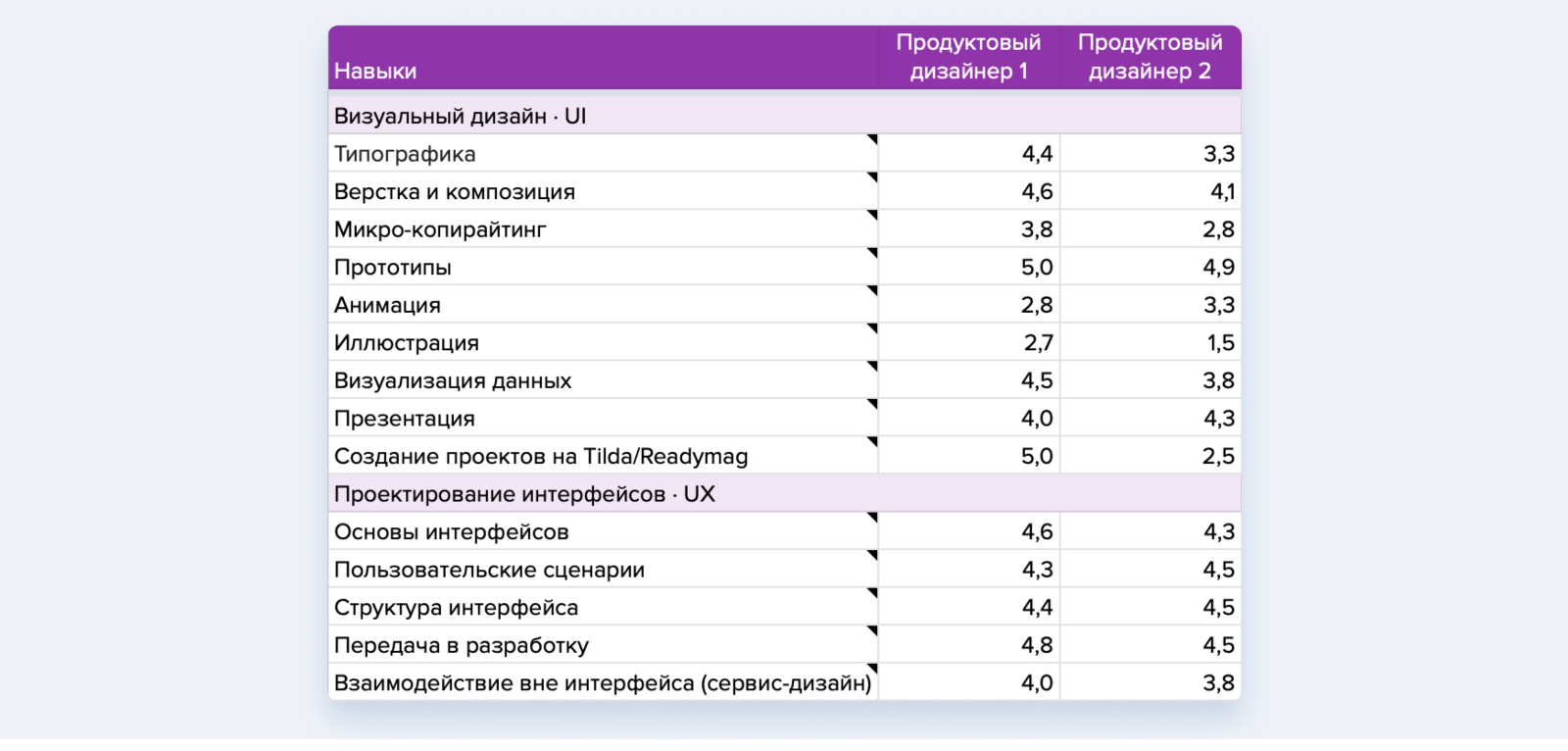
At such times, I dream of a team of 10–16 designers to compare them.
What skills require development - determined by two factors.
Focusing on problems alone is a dubious idea. 70% of attention and effort should be directed to the development of what the designer is already strong, and the remaining 30% - to clean up the tails and patch up holes in skills.
For example, product managers in a month will begin to actively conduct research on users. If the designer's assessment of this skill is closer to four points, then it makes sense to focus on its development.
At the end, a document is created for each designer, where it is written what skills you should pay attention to and recommendations for their development. In the short term - books, articles and people. In the long term - courses and mitapy.
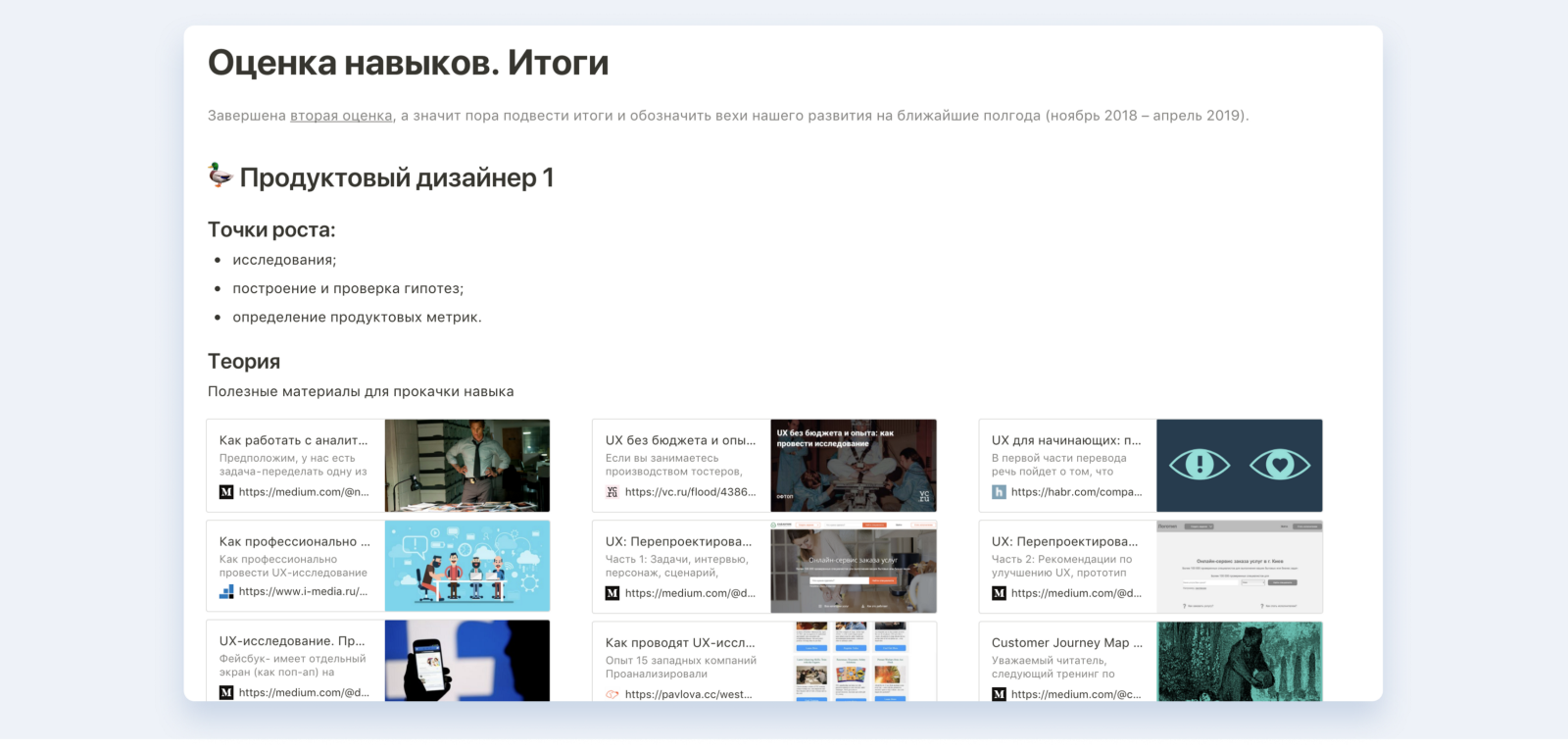
Articles, books, courses or mitapas
Everything is purely advisory in nature - no coercion. The purpose of the skill assessment is to show points for growth. And then the designer decides on his own - to develop or score.
Feedback after the evaluation was positive - the guys took up recommendations and showed good results. There were those who did nothing, but they also said that it was useful for them to look at their skills from the outside.
We took into account the mistakes of the past and begin preparing for the third assessment of skills, which will be held in late August.
How does your company approach the development of designers? With interest I will listen to you in the comments.
For the development of our design team, we stopped at two tools. And they complement each other.
First tool: levels in design
We have implemented a transparent growth system that solves long-term problems:
')
- designer - “it is not clear how to get an increase in salary and where to develop further, which courses to attend?” ;
- companies - "how to systematize the development of designers in the right direction?" .
Second tool: skills assessment
Helps to develop point hard and soft skills of each designer.
For a better understanding of how these two tools work, imagine that:
- levels in design - this tool is similar to a guidebook that shows the whole range of areas and points of growth for a designer;
- assessment of skills is similar to the dashboard, where you can watch the indicators and understand - the designer will be able to grow in the right direction or not.

I talked about levels in design in one of the past articles . Today I will talk about the assessment of skills: why this tool is needed, how we implement it and what we do with the data obtained.
Introduction
Designer's work is a set of versatile skills. Some are well developed, others are bad. This is normal when we “pump over” skills depending on the scope of their application.
But self-examination is difficult. Therefore, we have collected professional skills and grouped them into sections:
- visual design - UI ;
- interface design - UX ;
- research and analytics;
- management of yourself and projects;
- design artifacts.

Table link
Thanks to Yura Vetrov for the basic concept of the idea, which we adopted and developed to fit our needs.
Evaluation
We conduct an assessment every six months and, in order to be fairly objective, we stopped at this set of participants for each designer:
- 2-3 managers with whom he worked closely for the past six months;
- 1-2 designers who can give an objective assessment;
- supervisor;
- the designer himself.
So that everyone understands the terminology of skills in the same way, when you hover over them, a hint appears with a description.

Each skill has a short description.
Evaluation of skills occurs on a five-point system:
- - · "I do not know" ;
- 1 · bad, “knows nothing” ;
- 2 · superficial, “do not trust” ;
- 3 · average, "well, so-so" ;
- 4 · excellent, "you can trust" ;
- 5 · reputable, "he can teach himself . "
After several assessments, it was noticed that the guys often put fractional values - it means the scale is not enough. In version 3.0, let's move to a ten-point system.
Counting votes
To obtain objective results, we divided the final grade into two:
- the result is the average of the ratings of managers, designers and managers;
- My rating - as a designer appreciated himself.

This helps the designer himself to see two pictures of the world - how they see him from a colleague and how he positions himself. This works if more than two people have rated.
In a separate tab, each designer can see the results of colleagues and compare themselves with them.

At such times, I dream of a team of 10–16 designers to compare them.
findings
What skills require development - determined by two factors.
We improve the good, do not touch the bad
Focusing on problems alone is a dubious idea. 70% of attention and effort should be directed to the development of what the designer is already strong, and the remaining 30% - to clean up the tails and patch up holes in skills.
70% spend on skills development with four points and above, and 30% on skills with three points and above.
Product Interests
For example, product managers in a month will begin to actively conduct research on users. If the designer's assessment of this skill is closer to four points, then it makes sense to focus on its development.
At the end, a document is created for each designer, where it is written what skills you should pay attention to and recommendations for their development. In the short term - books, articles and people. In the long term - courses and mitapy.

Articles, books, courses or mitapas
Everything is purely advisory in nature - no coercion. The purpose of the skill assessment is to show points for growth. And then the designer decides on his own - to develop or score.
Results after two assessments
Feedback after the evaluation was positive - the guys took up recommendations and showed good results. There were those who did nothing, but they also said that it was useful for them to look at their skills from the outside.
We took into account the mistakes of the past and begin preparing for the third assessment of skills, which will be held in late August.
How does your company approach the development of designers? With interest I will listen to you in the comments.
Link to table
Source: https://habr.com/ru/post/456658/
All Articles